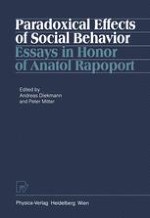1986 | OriginalPaper | Buchkapitel
Is it Always Efficient to be Nice? A Computer Simulation of Axelrod’s Computer Tournament
verfasst von : Christian Donninger
Erschienen in: Paradoxical Effects of Social Behavior
Verlag: Physica-Verlag HD
Enthalten in: Professional Book Archive
Aktivieren Sie unsere intelligente Suche, um passende Fachinhalte oder Patente zu finden.
Wählen Sie Textabschnitte aus um mit Künstlicher Intelligenz passenden Patente zu finden. powered by
Markieren Sie Textabschnitte, um KI-gestützt weitere passende Inhalte zu finden. powered by
The simplest model of a conflict between two parties is a 2 × 2 game. Each player has two strategies, say c (to cooperate) and d (to defect). If one takes only the rank order of the payoffs into account there are 78 nonequivalent 2 × 2 games (Rapoport, Guyer, Gordon 1976). The most extensively analysed of these 78 is Prisoner’s Dilemma (see Table I). Following the taxonomy of Rapoport (Rapoport et al. 1976) we define a 2 × 2 game as Prisoner’s Dilemma, whenever 1$$T > R > P > S$$ The paradox of Prisoner’s Dilemma is that each player gets — independent from what the other plays — a higher payoff when playing D. To defect is a so called dominant strategy. But when both players act individually rational and chose D both suffer from their individual rationality. Mutual cooperation would be collectively rational. The most outstanding situation which has (on an abstract level) such a structure is the arms race between the two superpowers.
